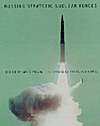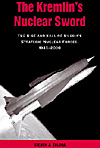Russian Strategic Nuclear Forces, edited by L. Podvig, MIT Press, November 2001, 620 pp, $45.00
The Kremlinís Nuclear Sword: The Rise and Fall of Russiaís Strategic Nuclear Forces, 1945-2000, Steven J. Zaloga, Smithsonian Institution Press, February 2002, 288 pages, $45.00
Every now and then, two books are published simultaneously on the same subject. Usually one or the other is better researched or better written, and becomes the dominant volume.
Recently, though, the fascinating topic of Russian/Soviet strategic nuclear forces has produced two fine books, both of which are worthy of consideration.
 The first, Russian Strategic Nuclear Forces from MIT Press, is a truly astounding work. This is a virtual textbook on the strategic nuclear forces of the former USSR and present-day Russia, filled with data that just a dozen years ago would have been classified Top Secret on both sides of the Iron Curtain.
The first, Russian Strategic Nuclear Forces from MIT Press, is a truly astounding work. This is a virtual textbook on the strategic nuclear forces of the former USSR and present-day Russia, filled with data that just a dozen years ago would have been classified Top Secret on both sides of the Iron Curtain.
The American edition of Russian Strategic Nuclear Forces started as a translation of a Russian volume, which was a collaboration of several expert authors. Ironically, the Russian edition of Russian Strategic Nuclear Forces has been removed from print and all copies seized by the Russian SVR/FSB (the successor to the Cold War KGB). The Russian authors are currently being prosecuted, one being arrested for his contributions despite Russian Strategic Nuclear Forces being derived from publicly available sources. P.L. Podvig and MIT Press have given the book a solid makeover, with a first-rate translation and addition of NATO designations to assist those who know the R-12 MRBM as the SS-4 Sandal.
There are chapters for almost every component of the Soviet/Russian strategic forces, from ballistic missiles and bombers to submarines and air defense systems. This is a comprehensive volume, with something for everyone interested in things Russian and nuclear.
 The second book, The Kremlinís Nuclear Sword, is the work of a more familiar source, long-time Soviet analyst Steve Zaloga. This is the second book on this topic by the prolific Zaloga, whose Target America (Presidio Press, 1993) provided an enticing early look at the subject.
The second book, The Kremlinís Nuclear Sword, is the work of a more familiar source, long-time Soviet analyst Steve Zaloga. This is the second book on this topic by the prolific Zaloga, whose Target America (Presidio Press, 1993) provided an enticing early look at the subject.
While less than half the length of Russian Strategic Nuclear Forces, Zalogaís book takes a different look strategic weapons development in Russia and the USSR, focusing on the political and historical events that drove their produc-tion. In this way, the growth of strategic forces is traced alongside Cold War events ranging from the Cuban Missile Crisis to the fall of the Berlin Wall. This context is something difficult to grasp at time, making Zalogaís excellent storytelling style most welcome.
More than just being informative, The Kremlinís Nuclear Sword is an entertaining and exciting read, something unexpected from a subject as technical and political as this.
The publication of these two books raises the question of which one is best for readers to buy. Quite simply, get both! Russian Strategic Nuclear Forces and The Kremlinís Nuclear Sword both have their unique qualities and focus. While both are somewhat pricey, both represent money well spent. There are occasionally package deals on Barnes and Noble.com and Amazon.com, which can provide discounts. However you get them, though, these are both fine books.
BT
Back to The Naval Sitrep #22 Table of Contents
Back to Naval Sitrep List of Issues
Back to MagWeb Master Magazine List
© Copyright 2002 by Larry Bond and Clash of Arms.
This article appears in MagWeb (Magazine Web) on the Internet World Wide Web.
Other military history and related articles are available at http://www.magweb.com